|
And then everything changed. Well, not quite everything. We still had the switch to colour that series 5 would bring, but in other respects, series 4 of The Avengers broke with the past and tok the programme in new directions. With the departure of Cathy Gale, Steed had a new accomplice in the shape of Emma Peel, played by a young Shakespearian actress named Diana Rigg, who for many young men of the time became the focus of wide-eyed erotic desire. It also saw the series move from video to 35mm film, which prompted a style shift from multiple camera studio recording to single camera drama, where each shot is individually captured and the structure and pace are constructed later in editing. For some of those involved with the previous series, this resulted in a loss of the earlier spontaneity, but it released the show from its studio setting and allowed a far greater level of locational and visual freedom.
For many of my generation, these were the episodes we still remember from childhood. It was our first experience of a series that seemed perfectly geared for kids growing up in the sixties, a lively crime drama that was laced with fantasy and that had more in common with Batman than social realist dramas like Z-Cars. These were the episodes where a metal man broke through doors and killed its victims with a swooping karate chop, where a house was assaulted by man-eating plants, where Emma was trapped under a giant steel press, where she and Steed arrived at an RAF base from which everyone had suddenly and mysteriously vanished. It was also the first outing of Laurie Johnson's magnificent new theme music, which has become as much a part of the Avengers identity as Steed himself.
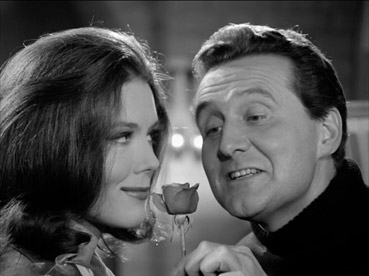
This time around I was coming from a different direction. Having watched the surviving episodes of the first three series in reasonably quick succession, I had fallen for their energy, invention and spontaneity, and developed a real fondness for the fabulous Honor Blackman. The style and personnel shift of series 4 thus came as a bit of a jolt, and I initially found myself just a little nostalgic for the series that was. It took a few episodes to adjust to the switch from witty reality-based espionage stories to more comic-book crime dramas with a fantasy or science fiction leaning, but it's definitely an adjustment worth making. The production values of these episodes are consistently excellent, the move to 35mm and the higher per-episode budget attracting established feature directors and a string of name actors, who by now were almost queuing up to guest on the show. It's no exaggeration to say that each episode plays like a small feature film, the cinematography and production design on a par with any contemporary British big screen equivalent.
Under writer and associate producer Brian Clemens' guidance, it's here that the series developed the flair for invention and very British eccentricity that for many defined just what made The Avengers the very special show that it was. That doesn't mean the series wasn't intermittently as much a victim to formulaic elements as its predecessors. The gunplay has been reduced from previous series, but just about every episode here climaxes in a punch-up to music, many of which feel curiously scrappier than their live broadcast equivalent. Every show ends with a light-hearted tag scene, and most with a wide shot of the pair riding away from the camera in one vehicle or another. If the identity of the chief villain is deliberately kept hidden then it's usually the person you'd least suspect, and as soon as a support character asks Steed or Emma to meet them later you know for certain he or she will be dead before the rendezvous can take place.
These are, however, relatively small gripes given the imagination and energy on almost constant display here. The casting of Diana Rigg is key to what makes the format shift work as well as it does – she completely inhabits the role of Emma Peel from the first time we meet her and peppers her performance with the sort of character detail that suggests she's been playing the role for years. Patrick McNee makes a confident transition from live video to film, and the very real chemistry between Rigg and himself brings its own special delight to their scenes together, and they pair have a fondness for fine alcoholic beverages that intermittently rivals that of Nick and Nora Charles from the Thin Man films. The series sometimes overplays its calculated eccentricity and more than once stumbles over its internal logic (which, contrary to popular belief, cannot be discarded simply because an element of fantasy has been added to the drama), but this does no real harm to a programme that remains one of the most adventurous, iconic and fondly remembered in TV history, and is still more genuine fun than anything you'll find on television today.
As on previous series, some changes have been made here to the original transmission order, which I've placed in brackets after the episode title. If you want to read up on the previous series, click the links in the side bar.
1. The Town of No Return (1)
A number of agents have mysteriously vanished from a small coastal town, which Emma visits as a government appointed schoolteacher, Steed as a location-scouting property developer. The locals are a guarded suspicious bunch and the school is strangely devoid of children, and there's something not quite right about the local airbase...
The style shift from earlier series is established here in the opening scene, when an agent walks out of the sea in a man-sized plastic bag and asks directions from a local, who reacts as if this sort of thing happens every day. New girl Emma Peel is introduced with the minimum of fanfare, but kicks off a determination to add an offbeat element to almost every scene by fencing with Steed around and over the furniture as they converse. Steed's exaggerated gentlemanly eccentricities have him produce a tea tray, cake stand and cutlery for their journey from a bag barely large enough to hold anything else, while his willingness to really press people for information is demonstrated when he pulls an uncooperative barman towards a lighted candle and ignites his moustache. The climactic punch-up is one of the scrappiest of the series, but a since copied gag in which we see only the results of a brawl between Steed and some soldiers (you'll even find a version of this in Park Chan-wook's Oldboy) is very nicely executed.
2. The Murder Market (7)
Eleven seemingly unrelated murders are somehow connected, at least according to an A3 sized line graph drawn up by Steed. While Emma pays a visit to the last victim's widow, Steed pops along to have his picture taken at a studio in which all those killed were recently photographed. He's pointed in the direction of high class dating agency Togetherness, and soon discovers that the service they offer extends beyond bringing lonely individuals together.
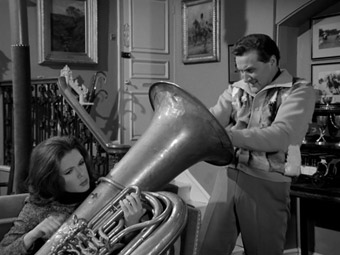
Bolstered by a splendid supporting cast that includes Patrick Cargill as prim agency owner Mr. Lovejoy, Peter Bayliss as the agency's flustered 'love counsellor' Dinsford, and RSC regular John Woodvine as the dead man's brother Robert, the episode is littered with the sort of offbeat detail the series became famous for, with Steed practising his putting and Emma playing a Tuba while they discuss the case, and Steed attempting to take the edge of Emma's weariness at having to temporarily play dead by hiding a bottle of champagne in her coffin.
3. The Master Minds (6)
Government minister Sir Clive Todd (Laurence Hardy) is shot and left for dead while taking part in the robbery of secret documents. He survives but is left with no memory of the crime or his involvement in it. With the incident in danger of bringing down the government (gets my vote), Emma keeps an eye on Todd as his private nurse, while the suicide of one of Sir Clive's colleagues points Steed in the direction of a MENSA-like organisation known as RANSACK.
Emma's intellectual superiority over her colleague is established here when her I.Q. is high enough not just to gain her entrance to RANSACK, but to land her a job at their training academy, while the only way Steed is able to pass the inaugural exam is to write the pre-supplied answers on his shirt sleeve. The revelation about the academy's true purpose fits the intriguing-but-implausible code by which series 4 seemed to live, and the supporting cast is as lively as ever, particularly Patricia Haines as games mistress Holly Trent, one of a string of assertive middle-class women who pepper the series and put a smile on the face of our Mr. Steed.
4. Dial A Deadly Number (10)
Steed and Emma investigate the deaths of a number of prominent company chairman, all allegedly by natural causes. Their only apparent connection is merchant banker Henry Boardman (Clifford Evans), whom Steed pays a visit under the guise of a wealthy investor, then introducing himself to top market player Ben Jago (Anthony Newlands). Emma, meanwhile, pursues her own route into this financial circle, which brings her into brief contact with handyman Fitch (John Carson), the man who arranged the most recent death. The question is how, and for what purpose?
Series 4 hits a notable high with this impeccably scripted (series regular Roger Marshall) and inventively directed (old hand Don Leaver) tale of deadly dealings in the London stock market. The dialogue is consistently excellent, particularly the sly verbal sparring between Steed and Emma when the latter is unexpectedly invited to a dinner party at which Steed expected to work alone. A personal favourite exchange:
Harvey (Peter Bowles): |
"Wasn't I right about the wine, Mr. Steed?" |
Steed: |
"And the Brandy. Impeccable." |
Mrs. Peel: |
"I thought Brandies were judicious?" |
Steed: (unfazed): |
"Not according to the authorised text." |
The episode anticipates the use of beepers as business accessories, and builds to an excellent climax in a wine cellar that imaginatively breaks with the roughneck fisticuffs of previous episodes and sees Steed floor a gunman by firing a champagne cork in his face.
5. Death at Bargain Prices (4)
When a top agent is killed while investigating the goings-on at a London department store, Emma goes undercover as a sales assistant, while Steed poses as an efficiency expert and tricks his way into see reclusive executive Horatio Kane. Many of the staff don't seem know their jobs, only a select few are invited to staff meetings, and others get fired for seemingly no reason. Something is definitely going on, but what?
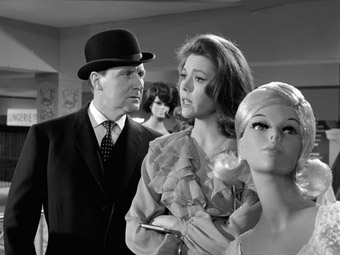
Plenty of intrigue here and the stakes are clearly high enough to ensure that anyone who even comes close to discovering the truth is quickly bumped off, and the crooks' true purpose is big time, even for The Avengers. Further enjoyment comes from a splendid supporting cast that includes André Morell, Alan Cuthbertson and T.P. McKenna (whose contract for this episode apparently lost him a role in Doctor Zhivago), and a couple of priceless exchanges. "I asked the chief predator where to find you," says Steed cheerily to salesperson Emma, "and he said, 'Our Mrs. Peel is in ladies' underwear' – I rattled up the stairs three at a time," to which Emma dryly replies, "Merry quips department on the fifth floor, sir."
We're left with one question though: why would a criminal organisation using a department store for a front and looking to keep their activities secret hire a real store detective instead of planting their own man in the role, then act all surprised when he does his job and investigates their suspicious activity?
6. Too Many Christmas Trees (13)
Steed is plagued by a series of stylised Christmas nightmares, and when Emma invites him to a seasonal bash at the house of publisher and Dickens enthusiast Brandon Storey (Dead of Night's main protagonist Mervyn Johns), he's confronted with real life incarnations of the imagery and characters from his dreams.
The spi-fi formula for which the series became famous is firmly established here, with Steed's dreams seemingly the result of telepathic activity, which in past episodes would have been exposed for the nonsense it is but which is here presented as the real deal. Once you accept this altered reality there's a lot of fun to be had with Steed's attempts to resist telepathic attack by boisterously singing Green Grow the Rushes, a song whose lyrics are a blend of Christian and Pagan mythology, subtly adding to the non-scientific mix.
The episode was directed by Roy Ward Baker, who two years later would helm Quatermass and the Pit, perhaps the greatest of all telepathy based science fiction films.
7. The Cybernauts (3)
The spi-fi continues with one of season four's most iconic episodes, in which Steed and Emma investigate the death of a number of corporate reps who were each killed by a single powerful karate blow. Emma joins a local karate school that looks exactly like a TV studio dressed to look like a dojo (funny, that), while Steed pays a visit to United Automation executive Oyama, played by the always wonderful Burt Kwouk.
The problem for the episode today is that it's title and fame have ensured that there's no real mystery about who or what is actually carrying out the killings. Steed's investigations lead him to wheelchair-bound Dr. Clement Armstrong (the excellent Michael Gough), whose fascination with computers and robotics pretty much tells you all you need to know. It matters not – the plot is well structured, the threat convincing (despite being a man in a silver suit), and I did wonder briefly if the Cybernauts themselves were an influence on later Dr. Who stories involving the similarly named Cybermen and the equally robotic Autons, who if I remember right were unleashed by Davros, another wheelchair-bound criminal mastermind...
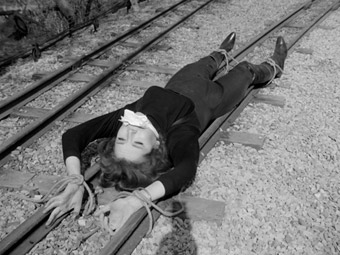
8. The Gravediggers (2)
Just the sort of episode to give those who prefer the reality base of the Honor Blackman years the heebie-jeebies, constructed as it is from a blend of pastiche and English eccentricity that's prepared to put the plot on hold for minutes at a time to indulge in one or both of these traits. Thus in their investigation of The Horace Winslip Hospital for Ailing Railwaymen, which appears to be in some way connected to the blocking of British defence radar signals, Steed can pay a visit to the hospital's railway obsessed founder and we get to spend five narrative-free minutes watching the ingenious process by which Winslip's butler Frederick (Charles Lamb) fakes the train journey on which his employer insists on taking tea. All caution is eventually thrown to the wind when the bad guys decide that the best way to stage an accidental death for Emma is to tie her to the tracks of Winslip's miniature railway and take a five minute run-up to kill her, giving Steed ample time to board the train, duff them up and save the day, all to a silent movie piano chase score. Fun, cleverly devised, but also rather silly, this is the series at its fluffiest, but is enlivened by a sprightly supporting cast that includes Ronald Fraser as Sir Horace Winslip and a young Stephen Berkoff as henchman Sager.
9. Room Without a View (15)
Two years after he inexplicably disappeared, leading physicist John Wadkin (Peter Madden) turns up unexpectedly at his house and tries to strangle his wife. It turns out he was one of seven prominent scientists who dropped off the map two years before, and Steed and Emma are called in to investigate in the hope of tracing their whereabouts. Ministry man Varnals (Peter Jeffrey) somehow works out that Wadkins was held in a specific prison camp in Manchuria, an experience that has left him emotionally shattered and unable to communicate. The trail leads to the upmarket Chessman hotel, at which Emma is reluctantly installed as a receptionist while Steed poses as a hotel guest, and when questioned on his behaviour by prim service manager Carter (the instantly recognisable Philip Latham), he claims to be Monsieur Gormet making an undercover investigation of the dining facilities. This gets him an invite to the table of hotel manager Max Chessman (Paul Whitsun-Jones), whose love of fine dining has been tempered by a comically restrictive diet. Are you getting all this?
A good balance of eccentricity, character humour and espionage plotting is struck here, and while you shouldn't have too much trouble working out what's going on, it's still ingenious enough to command respect for the plotting, though the explanation does suggest that room 621 at the Chessman has some of the best soundproofing that money can buy. As was common for the time, Wadkins Chinese wife Anna (played by a curiously uncredited Jeanne Roland) is about as oriental as Mrs. Peel, and if the bad guys really want to defeat Steed they should stop trying to stab him with bayonets and fire the bloody rifles they are attached to. The speeded up ending in which Steed pulls Mrs. Peel along on a rickshaw smacks a little of Benny Hill.
10. A Surfeit of H2O (8)
When a village poacher drowns in an open field, Steed and Emma investigate a nearby high-tech winery run by scientist Dr. Sturm (Albert Lieven), whose wine cellar is plays host to the sound of rainfall even when the weather outside is fine. Steed's in his element posing as a wine merchant and chatting up the centre's salesperson Joyce Jason (Sue Lloyd), while Mrs. Peel conducts a meteorological test that suggests the humidity in the aforementioned killing field is akin to that in the Amazonian rain forest.
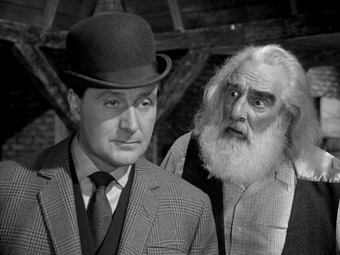
Biblical references abound in this unlikely but enjoyable slice of scientific hokum, which is blessed with an impressively underplayed German bad guy (whose assistant is played by a young Geoffrey Palmer) and the Noah-like Jonah (Noel Purcell), who is building an ark for the upcoming flood and in spite of his age proves a sprightly assistant for Emma and Steed when the going gets tough. There's no skimping on the rain effects either – an investigating meteorologist is killed by the most convincing torrential rainfall I've ever seen on the small screen.
11. Two's a Crowd (12)
Steed and Emma are charged with identifying a mysterious Russian agent named Psev, who is planning to infiltrate a defence conference for which Steed has been appointed chief of security. The problem for our boys is that nobody knows what Psev looks like, so Steed and Emma focus on his four-person entourage, led by stony faced Vogel (Julian Glover), who devises a plan to get into the conference when eager-to-please Russian Ambassador Brodny (Warren Mitchell) finds an exact double for John Steed.
Mid-60s attitudes have been captured in time by an episode in which Russians are portrayed either as humourless power-seekers or bumbling buffoons, and the willingness of the story to push the bounds of credibility are tested by a host of locational questions it retrospectively raises about Steed's cheery double, Gordon Webster. It's still damned good fun and as ever it's the enthusiasm of the performances that carry us over the logic holes.
12. Man-Eater of Surrey Green (11)
An top horticulturist inexplicably disappears and and is discovered by Steed working obediently as part of a team run by celebrated botanist Sir Lyle Peterson (Derek Farr). In the course of their investigation, Steed and Emma discover an experimental spaceship that appears to have crashed after colliding with a giant plant seed, which has been brought to earth with the craft. Could there be a connection to Peterson's work?
The fantasy elements hit a notable high in this Quatermass-like story in which Emma and Steed are climactically terrorised by a giant carnivorous plant. It sounds ridiculous, and in real world terms that's just what it is, but if you can make the faith leap then this is a solid and enjoyable science fiction tale, one in which oversized Venus fly-traps snap like terriers and electronic mind control devices can be beaten by hearing aids. Nicely developed by scriptwriter Philip Levene as a scientific detective story, it teams Emma and Steed with middle-aged botanist Laura Burford (Gillian Lewis), who could almost have strayed in from an Ealing comedy. There are plenty of enjoyable character moments and dialogue exchanges, my favourite being Steed's response to being asked Peterson if he drinks brandy: "If you mean am I accustomed to drinking Brandy, Sir Lyle, the answer is yes. If you mean would I like one now the answer is also yes." Uncharacteristically for such a gentleman, Steed uses an unconscious Emma as bait to poison the man-eating plant, then in one of the best/worst puns of the series describes himself as "a herbicidal maniac."
13. Silent Dust (14)
Where have all the martlets gone? Steed and Emma to nip out to the countryside to investigate why a species of birds has disappeared from a district of Cornwall in which they were once plentiful. Suspicion falls on an experimental fertiliser named Silent Dust, whose development was cancelled when it proved deadly to just about everything it touched. That's quite a chemical miscalculation. But if is Silent Dust is responsible, just who could be using it and why?
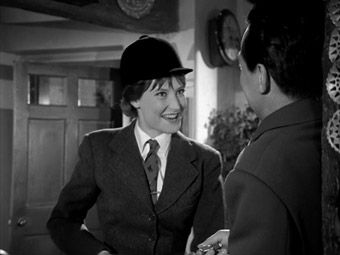
It's quickly established that local landowner Peter Omrod (Willaim Franklyn) is up to no good, though it's a while before we're let in on who else is involved and just what the dastardly cad is up to. Local colour is provided by Jack Watson as brutish farmhand Juggins, Norman Bird (ha ha) as agitated horticulturist Croft, the lovely Aubrey Morris as grinning ornithologist Quince, Isobel Black as artist Clare Pendergast, and Joanna Wake as assertively horsy Beryl Snow, whose brusque conversation with a play-along Steed prompts a reaction from Emma that had me giggling for ages, for reasons I still can't quite put my finger on. Steed quotes Oscar Wilde and references Wuthering Heights, and in a climactic scene of rather satisfying political slapstick, he beats a local huntsman with an anti-hunt placard and shoves the pointy end sharply between the man's fleeing buttocks. Good for you, sir.
14: The Hour That Never Was (9)
Steed and Emma are driving to a reunion at the RAF base at which Steed was once based when a dog runs into the road and causes them to crash. The car's a wreck, so its dazed but otherwise unharmed occupants make their way to the base on foot, entering through the back fence (Steed apparently knows the back way into every military camp in the country, except one) and finding the camp completely deserted, despite clear signs of recent human activity.
And so begins one of the best mystery thrillers of the series, one that really does keep you guessing for a good two-thirds of the running time and whose every development only adds to the riddle: a vehicle that can be heard but not seen; a small mountain of milk crates piled on a runway; a high pitched sound that knocks Steed and Emma senseless; a milkman who appears from nowhere and is shot down as he runs. And just when we seem to be getting a small handle on things, Steed is returned to the car crash and the whole thing starts all over again, but this time... Sorry, but that's all you're getting from me. Astonishingly, what shows every sign of being a full blown fantasy episode actually has a (sort of) plausible explanation, a mystery thriller in science fiction clothing. Roy Kinnear even pops up as camp scavenger Hickey. One of two episodes directed by Gerry O'Hara, the man behind recent BFI Flipside releases That Kind of Girl and All the Right Noises.
15. Castle De'ath (5)
When a British agent is found dead near a Scottish loch, Emma poses as a tourism advisor and visits a nearby castle on the invitation its co-owner Angus De'ath (Robert Urquhart), who wants to open the castle for visitors, against the wishes of his brother and laird Ian (our old friend Gordon Jackson). Already ensconced there is a not very Scottish Jock McSteed, under the guise of a historian researching a new book on the castle and its most famous resident, the dastardly Black Jamie, whose ghost continues to haunt its corridors.
Another episode whose fantasy elements are later revealed to have a dastardly real-world explanation. Quite how the bone-crushing four-poster bed and the sub-basement submarine housing were constructed without alerting those not involved in the scheme is probably best left unexplored, and the attempts at misdirection over just who is behind the whole thing don't really work in a series that too often targets the one your encouraged to least suspect. But this is still a fun episode that has Gordon Jackson on spanking form and Steed turning the tables on his captors in typically upbeat if unlikely manner. Steed's stunt double is particularly visible in a late episode fight.
16. The Thirteenth Hole (18)
Golf proves to be every bit as deadly as I always suspected when an agent named Ted Murphy, who was "keeping tabs on some scientific types," is bumped off at the thirteenth hole of his local club. Naturally Steed and Emma join up and start poking around, and the finger of suspicion soon points at club regular Frank Reed (Patrick Allen) and his caddy Jackson (Victor Maddern), whom we know are guilty because we saw them shoot Murphy in the opening scene.
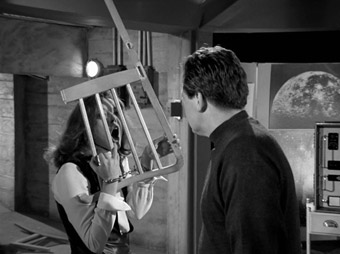
A relatively straightforward espionage story in which pretty much everyone turns out to be just what you suspected they were from an early stage. It's enlivened by the series' usual eccentricities, including a lovely mid-fight pause for Emma to impersonate a caged lion and an attempt to kill Steed by rocket-firing a golf ball at his head, something he survives because this week his bowler is lined with chain mail. Francis Matthews guests as Colin, "the club professional."
17. Small Game for Big Hunters (16)
In rural Hertfordshire, a tropically dressed farm hand named Gatt Kendrick (Peter Thomas) falls out of the woodland with a Kalayan arrow in his back and straight into a coma. After calling on the advice of tribal medicine expert Professor Swain (Liam Redmond), Steed follows up on a clue provided by Kendrick's garb and pays a call on a Colonel Rawlings (Bill Fraser), who together with his subordinate Simon Trent (James Villiers) has created an artificial tropical jungle to relive his glory days fighting the fuzzy-wuzzies, but there's clearly more going on here than bluff British eccentricity.
A rare example of an Avengers episode that's just a little time-trapped by its content and characters, with colonial white officers and black tribal savages, though the latter is neatly usurped when one of the natives turns out to be a Kalayan intelligence officer with a public school accent. The underlying villainy is ingenious and plausible and even has something of a contemporary ring, though in one of the less well aged gags Steed gets to swing from a vine and say "Me Steed!"
18. The Girl From Auntie (17)
Emma is kidnapped, and when Steed returns from his summer hols and drops round to see her he instead finds an actress named Georgie Price-Jones (Liz Fraser), who's been hired to impersonate Mrs. Peel but not told why. Steed and Georgie team up to follow a series of interconnected leads in an attempt to locate the real Emma, but find everyone who might be able to throw light on the case has been murdered with a double-O knitting needle. The trail eventually leads them to an organisation whose dirty work is carried out by a squadron of innocent looking old ladies.
One of those stories that requires a faith leap to swallow and that's not above winking at the audience – "Six bodies in half-an-hour. What do you call that?" Steed asks the remarkably composed Georgie, who replies without pause, "A good first act." It's still a fun episode and popular with series fans, though one that its original writer Roger Marshall does not remember with affection.
19. Quick-Quick Slow Death (19)
When a top enemy agent is caught attempting to dispose of a body (though given that he transports it in a pram which he leaves on a slope while he pops in to make a phone call, I'm wondering just how smart these agents are), the only clue to the dead man's identity is a distinctive tattoo on his forearm. While Steed's chases a series of connected enquiries, Emma pays a visit to a jovial tattooist who operates his needle like he's beating an egg, then calls on an over-attentive shoemaker with wild foot fetish. The trail eventually leads to a dance studio, where Emma secures a job as an instructor and Steed enrols as a debonair new student.
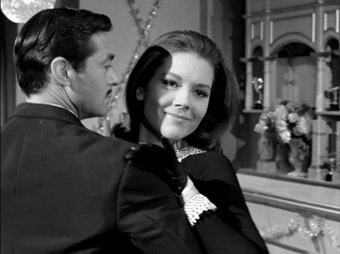
One of those episodes that runs with new format and seems determined to have fun with just about everything, from Steed's window-to-window conversation with a restless bank teller to the amusing skip that Emma performs as she enters the dance studio for the first time. Restraint is intermittently thrown to the wind, and those who prefer their Avengers episodes grounded in reality will likely be wide eyed in disbelief at a shoemaker whose rampant fetishism and faked Mediterranean accent would frighten away all but the most hardened customer, and a tattooist who spends his dying minutes tattooing a carefully worded clue on a garlic sausage. Quietly stealing every scene he appears in is Larry Cross as drunken bandleader Chester Read.
20. The Danger Makers (20)
When the middle-aged General Woody Grove is knocked from his motorbike while playing chicken with a truck, Steed visits the base on which he was stationed, and discovers a number of formerly active army officers have been deliberately placing themselves in physical peril in an attempt to recapture a sense of mortal danger that army life no longer provides, a secret they're prepared to kill to protect. Emma is invited to join their society after selling herself as a closet thrill seeker to group member Major Robertson (Nigel Davenport), a process that requires her to undertake a potentially lethal initiation test.
A episode that strikes a near-perfect balance between its fantasy and reality elements, largely because the former so ably serves the latter, which sits firmly on the right side of plausibility – the concept of a group who risk life and limb for the buzz of doing so has its modern equivalent in the adrenaline junkies of today, while cases of ex-soldiers who have unable to adjust to the comparatively humdrum nature of civilian life are well documented. In this respect the plot really didn't need the caper element that their activities all build to, but there you go. The handling of Emma's initiation test is a series highpoint, with the good lady required to carefully traverse a deadly version of a wire loop game where a wrongly timed mistake will result in her instant electrocution. Knowing full well she'll survive does nothing to lower the tension.
21. A Touch of Brimstone (21)
A series of pranks against public figures takes a dark turn when one of them is killed cutting an opening ceremony ribbon. All fingers point to Honourable John Cleverly Cartney (Peter Wyngarde), a self-confident libertine who runs a modern day revival of the notorious Hellfire Club, whose members meet to eat, drink and indulge in acts of cheerful debauchery. While Steed seeks membership through traditional channels, Emma woos Cartney and is presented to the members at a special banquet as "The Queen of Sin."
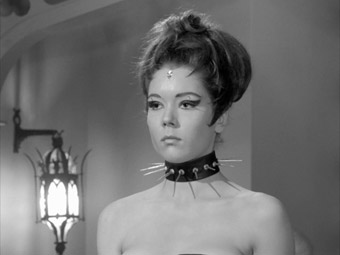
Can there be an Avengers fan alive who is not fully aware of A Touch of Brimstone? It's generally agreed that the episode's initial American ban resulted has less to do with its censorship-restricted depiction of sexual debauchery than Cartney's whip assault and Emma's still eye-popping 'Queen of Sin' costume, consisting of a spiky dog collar, black whalebone corset, economically cut briefs, leather boots, goth eye make-up and a python, an image that confirmed Emma Peel up as a kinky sex goddess and provided a poster image for adolescent fan-boy bedroom walls everywhere. Fortunately there's a lot more here than sexual titillation – A Touch of Brimstone is a strong episode all round, having a well developed narrative, a commanding performance from Peter Wyngarde as Cartney, and a standout scene involving Steed's capacity for alcoholic intake and an initiation test involving a pea and a cleaver.
22. What the Butler Saw (22)
Government secrets are being leaked to the enemy and suspicion has narrowed to three potential suspects: Brigadier Goddard (Howard Marion Crawford), Vice Admiral Willows (Humphrey Lestocq) and Group Captain George Miles (Denis Quilley), all of whose butlers have recently been replaced by ones from the same agency. Aha... Steed joins the agency's butling school and is soon top of the class, while Emma hooks up with Group Captain Miles, a man with a bit of a reputation with the ladies.
An episode that's more espionage than fantasy based, though the idea of three leading military figures huddling together in a sealed plastic tent in the name of security is silly enough to remind us which show we are watching. The game-playing between Emma and Miles has its amusement, particularly once Steed is installed as the latter's butler, and the push-button transformation of his living room to an almost comical representation of a playboy apartment temporarily puts Miles in the same league as Family Guy's Quagmire. Fun, well done, and with it has John Le Mesurier as lead butler Benson.
23. The House That Jack Built (23)
Emma drives out to the Hampshire countryside to inspect a house bequeathed to her by her late uncle Jack, whom she wasn't even aware of until she received a letter from her lawyer informing her of his passing. That's hardly surprising, since there was no such uncle and her lawyer sent no such letter, something Steed discovers some time after her departure. And this is no ordinary house. Emma quickly finds herself trapped in a strange room with an electronic device at its centre and corridors that appear to lead away but repeatedly return her to the same spot. But just who has lured her here, and why?
Just how much plot to reveal of this ambitious, adventurous Brian Clemens episode is a difficult call, but I'm happy to cut it short there and avoid spoiling things for newcomers. As the only person on screen for much of the time, Diana Rigg really gets the chance to shine, though her co-star here is art director Harry Pottle, whose eye-catching designs for the mystery room is a bewitching blend of sixties experimentalism and Dr. Caligari style expressionism. Full marks, too, for daring to tell at least part of the story in almost purely visual terms, which is unnecessarily disrupted by a thoughts voice-over that feels a little too much like the producers were worried the audience wouldn't be able to follow Emma's thinking unaided. No matter, this is still a worthy fan favourite whose boldness and invention make its few logic hiccups (Emma would have to be seriously drugged up not to notice the room she was in was moving quickly enough to make objects within it roll about) easy to forgive.
24. A Sense of History (24)
When an economist with a plan to rid the word of poverty is murdered by rag week students dressed as Men of Sherwood, Steed and Emma go undercover at local public school St. Bodes, where their attention is drawn to a group led by the anarchic Eric Duboys (Patrick Mower), who reject traditional schools of thought and are instantly suspicious of the two outsiders.
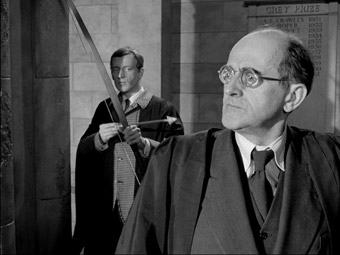
A rare example of a series 4 Avengers story that identifies the bad guys and their motivation at an early stage, leaving only the matter of how Steed and Emma will turn the tables on them for the episode to resolve. The fun lies as ever in the detail and performances, with Emma dressed up as an impish Robin Hood and Patrick Mower guesting as an appropriately arrogant and bullying Duboys. We also get a welcome glimpse of the more dangerous Steed of old when he physically responds to Duboys' misguided attempt at intimidation. "If Duboys gives you any more trouble, just report him to the proctor," the master who intervenes advises. "I'll do better than that," Steed smilingly replies, "I'll break his arm."
25. How to Succeed.... at Murder (25)
A number of key businessmen have been murdered by attractive young girls, leaving behind filing systems so complex that they can only be understood by their secretaries, who are thus placed in temporary charge of the companies for which they work. A scent detected at one of the murder scenes steers Steed and Emma in the direction of a secretarial agency, which Emma enrols in and Steed consults, masquerading as just the sort of friendless millionaire who would make a perfect target for murder and secretarial takeover.
Fear of feminism appears to lie at the heart of this engaging if wildly implausible story of women fighting back against male domination of the corporate world, led by a female ventriloquist's dummy and her hen-pecked human husband (Artro Morris). The sort of show that could only have been written and directed by men, with Brian Clemens' new fondness for Carry-On style puns providing us with a keep-fit class run by a couple named Henry and Henrietta Frogbottom, and a perfumer named J.J. Hooter whose olfactory skills rival those of Jean-Baptiste Grenouille. The episode title is doubtless a reference to the 1961 Pulitzer Prize-winning Broadway hit How to Succeed in Business Without Really Trying.
26. Honey for the Prince (26)
Two agents are shot whilst working undercover, one of whom survives long enough to drop in on Steed before he expires. His dying words and the contents of his colleague's apartment send Emma and Steed on different errands, she to a honey shop and he to the Quite Quite Fantastic Company (run by a typically animated Ron Moody), which enables its customers to live out their fantasies in a sort of low tech version of the ever malfunctioning holodecks on Star Trek. Their enquiries point to a possible assassination attempt against visiting Barabian Crown Prince Ali (Zia Mohyeddin), and with Britain once again looking to broker an oil deal, that would simply never do.
What How to Succeed.... at Murder did for the women's movement, Honey for the Prince does for the image of Arabian (sorry Barabian) royalty, with the bonny Prince Ali protected by burly, stripped-to-the-waist black guards and surrounded by doting, scantily clad women from his harem of three hundred and twenty wives, whom he services according to a set timetable. He's also an avid cricket fan, and on Steed's arrival he changes into his cricketing whites at a speed that would leave Clark Kent green with envy, and engages in a game that in anything approaching the real world would probably kill everyone in the room. Fans of Mrs. Peel get to watch her do the dance of the six veils ("She was poorly educated, your majesty"), prompting Ali to offer to buy her for twelve goats. Clemens' new penchant for bad pun names gives us a Honey shop owner in a striped pullover called B. Bumble, who is played with some enthusiasm by Ken Parry.
As I've already mentioned, series 4 of The Avengers moved from video to film, 35mm film no less, the very same format on which most feature films continue to be shot to this day. You'd thus expect the picture here to look pretty good. It looks amazing. OK, we're still talking DVD here, and knowing the variance in TV and player upscaling abilities I may well be luckier than some on this score, but the seven discs here could well be the best looking DVDs I've seen all year. The contrast is near perfect, the sharpness and level of detail extraordinary for a non-HD format, and the richness of the image sings a hymn to the glories of 35mm film. Grain is minimal, there's not a trace of damage and there's hardly a dust spot to be seen. The only question is, with a restoration this good, why are we looking at DVD rather than Blu-ray discs?
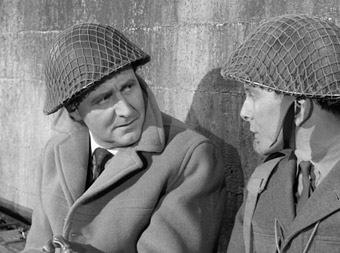
The Dolby 2.0 mono soundtrack is also up to par, the slight narrowing of the dynamic range that's common for TV and film works of the period causing no problems with dialogue or music, both of which are clearly reproduced throughout. There is no trace of background hiss or damage.
As with Optimum's previous Avengers releases, this seven disc set is loaded to the gills with extras, which are spread across all seven discs.
Disc 1
The Town of No Return commentary with Brian Clemens and Roy Ward Baker
Series devotee and regular compère Jaz Wiseman plays knowledgable host and feed man to associate producer and writer Brian Clemens and director Roy Ward Baker on a typically information-packed look back at the production of the first episode of the series. Many of the questions that Wiseman asks here are also posed on subsequent commentaries – reactions to the new music and opening credits, the casting of Diana Rigg and her chemistry with McNee, the move from videotape to film, working with producer Julian Wintle, and so on – but there is plenty of discussion on the episode itself and a number of enjoyable and revealing anecdotes. The initial casting and eventual replacement of Elizabeth Sheperd in the Emma Peel role is covered in some detail, and the fact that this entire episode was initially filmed (by Peter Graham Scott) with her in the role leaves you intrigued for footage that is apparently now lost. As with his commentary of the DVD of Quatermass and the Pit, Roy Ward Baker is reluctant to discuss aspects of the production that he feels would spoil the magic, but does talk fondly of how much he learned as assistant director to Alfred Hitchcock on The Lady Vanishes.
The Master Minds commentary with Robert Banks Stewart
Screenwriter Robert Banks Stuart reveals how the story for this particular episode came about and talks about the writing and production process, why the series has dated so well, and why it stood out from some of the more cliché-ridden British movies of the time, as well as responding to the generic questions mentioned above. He reveals that he was less fond of the series' new fantasy elements, and that he wrote the first pre-Dr. No draft of Casino Royale, when Patrick McGoohan was being touted to play Bond. The passing of time has left him unsure whether a silhouetted fight that takes place behind a film screen was something he wrote or a Brian Clemens addition.
Interview with Elizabeth Sheperd (10:39)
A telephone interview with the actress who was initially cast as Emma Peel, only to be dropped and replaced halfway through the filming of episode 2. Having heard Clemens' version of why she was recast, this is a welcome opportunity to get the other side of the story, though it does seem to confirm Clemens' claim that she was a little over-enthusiastic with suggestions for changes (something the writer revealingly states in his commentary he doesn't like other writers doing, let alone actors). A surviving shot of her hands that was included in first episode is included.
Armchair Theatre – The Hothouse starring Diana Rigg (53:12)
Written by actor Donald Churchill, who also co-stars, this installment of the long running series of TV plays was first screened in December 1964 and indirectly led to Diana Rigg being targeted by the Avengers team. She plays Anita Fender, the wife of supermarket chain manager Harry Fender (Harry H. Corbett, an Armchair Theatre regular who had already struck comedy gold as Harold Steptoe in Steptoe and Son) who, after a staff party at which Harry dances with Charlotte (Miranda Connell), the wife of store supervisor Gordon Parsley (Churchill), invites the couple to their home for dinner in an effort to confirm suspicions of her husbands infidelity. There's nothing that secial about the story itself, but the power play politics are nicely incorporated and there are some memorable exchanges and character interplay, particularly those involving either Rigg or Corbett, or preferably both. With so few of the Armchair Theatre episodes available on DVD, this is an especially welcome and a most appropriate extra.
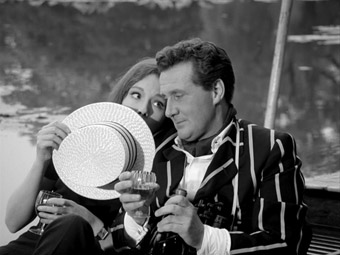
The Master Minds alternate UK Opening and Closing Credits (3:22)
Although set to Laurie John's fab new theme music, these lithographic image titles are far closer to those of season 3 than what was became the standard for the series. Includes the opening scene, episode title and final tag scene.
The Master Minds alternate UK bumper slate (0:25)
An intriguing lithographic alternative to the typeface bumpers used.
Standard UK bumper slate (0:18)
The ad break bumpers for completists.
USA chessboard opening sequence (0:29)
A live action opening sequence that should ring a small bell even with UK viewers, in part for its influence on the opening titles of subsequent series. The urgent American voice-over should raise a smile.
Image Galleries
Substantial production still galleries for all three episodes on the disc, plus a fourth featuring Elizabeth Sheperd as Emma Peel, where she visually appears closer to Cathy Gale than Diana Rigg's version of Emma. There are a lot of stills of her bondage-bound in horse riding attire, which lends some credence to her claims that the producers were a little obsessed with leather, rubber and bondage. The odd colour photo is mixed with the monochrome.
DVD-ROM material
Pop the disc into your computer and you'll have access to the official studio episode synopses for all three episodes on the disc, dialogue sheets (basically a version of the script that includes only the dialogue and laid out in theatre rather than film script format) for The Master Minds and Town of No Return, a draft script for The Murder Market, and the covers and relevant pages from TV Times and TV World of the period, all in PDF format.
Disc 2
Commentary on Dial a Deadly Number with Roger Marshall
Episode writer Roger Marshall answers the usual generic questions, and despite his happiness with Don Leaver's direction and his enthusiasm for Diana Rigg and Laurie Johnson's new theme, has mixed feelings about the direction the series took from here on in. The move to film saw him less involved in the production of his episodes and he remembers the video years as more fun to do, but it's Clemens' script tinkering that seems to have left a particular impression, with the result that he dislikes his later episodes, describing The Girl From Auntie as "a travesty." He is enthusiastic about his subsequent work on The Sweeney and clearly enjoyed the energy of that show.
Colourised test footage from Death at Bargain Prices (1:11)
The results of a test made in the 1980s to 'colourise' the monochrome Emma Peel episodes, transferred from a VHS copy owned by Dave Rogers, author of a number of books on the series, after the master material mysteriously disappeared. As you might imagine it looks rather horrible, with unnatural colours and no account made for the fact that the footage was lit for black and white rather than colour.
Alternative End Tag Scene from Death at Bargain Prices (1:20)
Alternative dialogue and noticeably more artificial back projection.
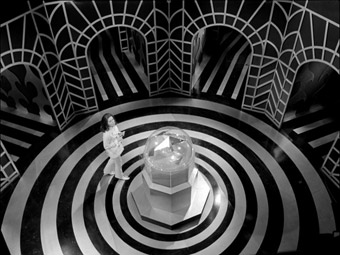
Image Galleries
Another set of substantial image galleries for all four episodes. The images for all episodes are arranged in order of story chronology when they are records of specific scenes.
DVD-ROM material
PDF documents of the episode synopsis for all four episodes on the disc, scripts for dialogue sheets for Dial a Deadly Number, Death at Bargain Prices and Too Many Xmas Trees, the original script of The Cybernauts and a draft script for Too Many Xmas Trees.
Disc 3
Variant Opening Title Credits for The Gravediggers (3:00)
Play spot the difference with two alternate episode title sequences from The Gravediggers.
German Opening Titles (0:47)
The original title sequence with an animated front end and German credits. In Germany the show is called Mit Schirm, Charme und Melone, which Google translates as "With screen charm and melon." Oh surely not. But then there's...
French Opening / Closing Titles (1:50)
In France the show was called Chapeau Melon et Bottes de Cuir, which apparently translates as "Melon Hat and Leather Boots." I'd love to know what it was called in Japan. Anyway, except for the Frech text, both sequences are the same as their UK equivalent.
Image Galleries
Production stills for all four episodes on the disc.
DVD-ROM
Studio synopses and dialogue sheets for all four episodes, plus a press release for Surfeit of H2O.
Disc 4
The Hour That Never Was commentary with Gerry O'Hara
Now here's something of a coup for the set, a commentary by episode director Gerry O'Hara, something you'll find on neither of the recent BFI flipside discs of his feature films All the Right Noises and That Kind of Girl. And a most worthwhile commentary it is, as O'Hara details how he came to direct his two episodes and talks in some detail about the shoot itself and the pleasures of working with this cast and crew, remaking that "It's only when you've worked with some of the horrors that you realise how decent these people are." He's generous to a fault to Roger Marshall's screenplay, claiming it was the best he's ever been given and that ninety percent of what you see on screen was down to Marshall's writing, and that all he really had to do was follow it's lead. His respect for his actors is obvious, and there's an interesting anecdote about directing Bill Fraser on Small Game for Big Hunters. His recollection of working as assistant director on Our Man in Havana prompts him to nominate Carol Reed as the finest director Britain has ever produced.
Episode Reconstruction: Kill the King (14:30)
Another reconstruction of a lost episode from season 1, which in the manner of those on the Series 3 box set is ably narrated and by David G. Hamilton and visually illustrated by production stills. An intriguing tale of Far Eastern oil concessions, revolutionary politics and attempted assassination, the episode was written by James Mitchell and guest starred Burt Kwouk as King Tenuphon, Patrick Allen as his security officer General Tuke, and Peter Barkworth as Foreign Office man Chrichton-Bull, who effectively stands in for a busy David Keel here.
Image Galleries
The usual production stills for the four episodes on the disc.
DVD-ROM material
Studio synopses for all four episodes, dialogue sheets for Castle De'ath, The Hour That Never Was and the Maneater of Surrey Green, the shooting script for Silent Dust (originally titled Strictly for the Worms), the draft script for the Hour That Never Was (which was then titled An Hour to Spare), and a press release for Castle De'ath.
Disc 5
ITN Newsreel Footage
Four very brief snippets of Avengers-related ITN newsreel footage, namely an Avengers themed Fashion Show (0:50) in which models parade designs based on Diana Rigg's seies wardrobe, a post ceremony snippet of Patrick McNee's Wedding (0:32), and a very short Diana Rigg Interview (0:38), which appears to have been conducted shortly after she landed the role of Emma Peel. Probably the most in need of some explanatory text is Avengers Sold to America (0:13), in which a cheerful Patrick McNee and Diana Rigg simply walk up to a car and get in it.
Episode Reconstruction – Dead of Winter
Another welcome reconstruction of a lost first series episode, again narrated by David G. Hamilton and accompanied by surviving production stills. An intriguing nod in the direction the programme was later to take sees the science of cryogenics incorporated into a political crime narrative, and in a rather nice touch sees the fascist bad guys successfully challenged by a group of dock workers. The episode was written by Eric Paice and directed by Don Leaver, and guest-starred Norman Chappell and Carl Duering.
Reconstructed John Stamp Avengers Trailer
Another extra that would benefit from a little contextual background, this is a reconstruction of an animated Avengers trailer using graphical images by John Stamp.
Image Galleries
The usual production stills for all four episodes.
DVD-ROM material
Studio synopses for Quick-Quick Slow Death, The Thirteenth Hole, Room Without a View and The Girl From Auntie, dialogue sheets for Small Game for Big Hunters, The Thirteenth Hole and The Girl From Auntie, and the rehearsal script for Dead of Winter, the reconstructed episode from series 1.
Disc 6
The House That Jack Built commentary with Don Lever
One of the most distinctive episodes of the series proves a good choice for a commentary track by regular series director Don Lever, one of only a couple of directors invited to make the move from video to film in producer Julian Wintle's determination to 'upgrade' the show. His recollections of the transition are particularly interesting, particularly the snobbery shown by film people towards those who had trained in television. He also has plenty to say about the episode itself, though does credit art director Harry Pottle as the show's real star, and more than one gushes at Diana Rigg's beauty. His other episodes from the series are touched on, though host Jaz Wiseman doesn't get far with How to Succeed.... at Murder because Leaver has no recollection of actually directing it.
Colourised test footage from A Touch of Brimstone (1:38)
Another nibble of colourised test footage that's been preserved by author Dave Rogers, this time consisting of three sequences from the series' most notorious episode (want to guess which ones?). What look's like second generation VHS makes the colours look even more unpleasant, though the bronze tinted snake looks better than expected.
Image Galleries
The usual image galleries for all four episodes on the disc. I can guess which one most will head for first.
DVD ROM material
Official synopses for all four episodes, dialogue sheets for A Touch of Brimstone and The Danger Makers, and shooting scripts for The House That Jack Built and What the Butler Saw.
Disc 7
The Strange Case of the Missing Corpse (3:09)
A lively, light-hearted and self-referential trailer for a (probably) non-existent colour (sorry, 'color') episode entitled The Strange Case of the Missing Corpse that plays almost like a parody of the show, as Steed and Emma outline the standard plot and action elements of the average episode. Steed even slyly addresses the camera at one point.
Image Galleries
The usual production stills for each of the three episodes, plus a collection of general publicity stills, including several of Diana Rigg in various costumes, plus 4 production stills from The Strange Case of the Missing Corpse.
DVD-ROM material
Synopses and dialogue sheets for all three episodes, a press release for A Sense for History and a sizeable collection of production memos.
A terrific series that for many – box set co-ordinator Jaz Wiseman included – is where The Avengers artistically peaked. There's not a single duff episode here, and even the weaker stories are so well made, so energetically performed, so littered with invention and so much damned fun that it seems churlish to complain. Optimum's box set is a true standard setter, with immaculate transfers and a lorry load of excellent extras. A Blu-ray release would really been the business (check out Network's release of The Prisoner for an idea just how good it could have looked), but if you're an Avengers fan the set still comes highly recommended.
|